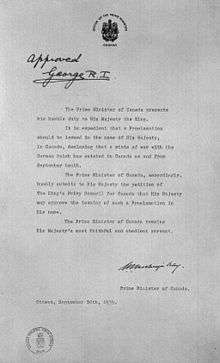Declaration of war by Canada
A declaration of war by Canada is a formal declaration issued by the Government of Canada (the federal Crown-in-Council) indicating that a state of war exists between Canada and another nation. It is an exercise of the Royal Prerogative on the constitutional advice of the ministers of the Crown in Cabinet and does not require the direct approval of the Parliament of Canada, though such can be sought by the government. Since gaining the authority to declare war under the Statute of Westminster 1931, Canada has declared war only during the Second World War.[1][2]
Second World War
Germany

After Germany invaded Poland on September 1, 1939, the United Kingdom and France declared war on September 3.[2][3] To assert Canada's independence from the UK, as already established by the Statute of Westminster 1931, Canada's political leaders decided to seek the approval of the federal parliament to declare war.[1][2][4][5] Parliament was not scheduled to return until October 2, but returned to session early on September 7 to consider the declaration of war.[2][3][4][5][6]
On September 9, the House of Commons and Senate approved authorization for a declaration of war. The Cabinet then drafted an Order in Council to that effect. On September 10, Vincent Massey, Canada's High Commissioner to the United Kingdom, brought the document to King George VI, at the Royal Lodge, Windsor Great Park, for his signature,[7][8] whereupon Canada had officially declared war on Germany.[2][3][4][5][6][9] In his capacity as the government's official recorder for the war effort, Leonard Brockington noted: "King George VI of England did not ask us to declare war for him—we asked King George VI of Canada to declare war for us."[10][11][12]
Fascist Italy
On June 10, 1940, Italy declared war on France and the United Kingdom.[2][3][9] National Defence Minister Norman Rogers had been killed in a plane crash that day.[9] Both houses of parliament approved a declaration of war and the Cabinet issued the Order in Council the same day. It was submitted to the King and the proclamation was read by the Prime Minister to parliament the following day.[2][3][9]
Finland, Hungary, Romania, and Japan
Parliament adjourned on November 14, 1941, and was not scheduled to return until January 21, 1942.[2] At the urging of the Soviet Union, the United Kingdom declared war on Finland on December 6, 1941.[13] At the UK's urging, the Canadian Cabinet the next day issued a proclamation declaring war on Finland,[13] Hungary, and Romania.[2]
On December 7, 1941 (December 8 in Japan), the Empire of Japan began an undeclared war upon the United Kingdom (invading Hong Kong and Malaya), Canada, and the United States (attacking Pearl Harbor).[3] Mackenzie King and the Cabinet decided to go to war with Japan that evening and issued a proclamation the following day declaring that, as of December 7, a state of war existed between Japan and Canada.[2][3][14] One day later, the US and UK also declared war on the Japanese Empire.[3] These proclamations were presented by Mackenzie King to the House of Commons when parliament returned on January 21, 1942.[2]
See also
References
- Fortin, Steve (6 February 2008). "Is "declaration of war" an antiquated expression?". The Maple Leaf. Department of National Defence of Canada/Canadian Forces. 11 (5): 6. Archived from the original on 23 September 2012. Retrieved 23 May 2011.
- Rossignol, Michel (August 1992). "Parliament, the National Defence Act, and the Decision to Participate". Public Works and Government Services Canada. Retrieved May 23, 2011.
- "1939: King prepares Canada for war with Germany". CBC Digital Archives. Retrieved May 23, 2011.
- Granatstein, J. L. (September 9, 2009). "Going to war? 'Parliament will decide'". The Globe and Mail.
- "Canada and the World: A History — 1939 - 1945: The World at War". Department of Foreign Affairs and International Trade of Canada. Retrieved May 23, 2011.
- Partners for Victory: Canada and the United Kingdom in World War II (PDF). High Commission of Canada to the United Kingdom. p. 2. Retrieved May 23, 2011.
- Donald Creighton, The Forked Road: Canada 1939-1957, McClelland and Stewart, 1976, p.2.
- Brode, Patrick (1 May 2006), "War power and the Royal Prerogative", Law Times, Thomson Reuters Canada Ltd., archived from the original on 22 November 2012, retrieved 2 August 2012
- "Allies take Sicily". CBC Digital Archives. Retrieved May 23, 2011.
- Canada at War. Office of Director of Public Information of Canada (9–20): 7. 1941. Missing or empty
|title=(help) - Railway carmen's journal. Brotherhood Railway Carmen of the United States and Canada, Brotherhood Railway Carmen of America. 47-48. 1942. Missing or empty
|title=(help) - Debates. House of Commons of Canada. 3: 2537. 1942. Missing or empty
|title=(help) - Lindström, Varpu. "History of Finland-Canada Relations". Embassy of Finland, Ottawa. Retrieved May 23, 2011.
- "Canada Declares War on Japan". Inter-Allied Review via ibiblio. December 15, 1941. Retrieved May 23, 2011.